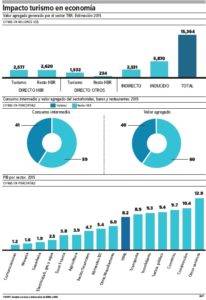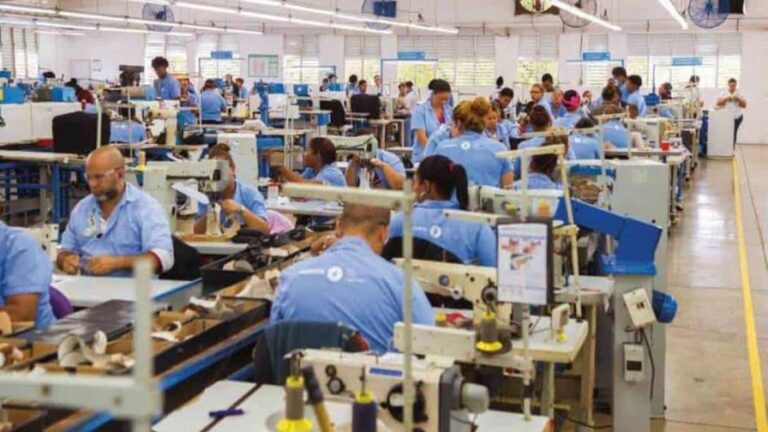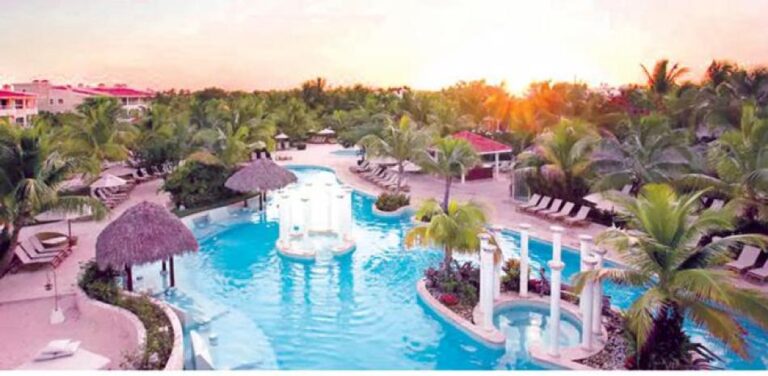Si se toman en cuenta los efectos multiplicadores, se podría estimar que el PIB vinculado a la actividad de hoteles, bares y restaurantes (HBR) y Turismo, Bares y Restaurantes (TBR) supera los US$15,000 millones.
Esto equivale a un efecto multiplicador de 1.7 respecto a HBR y 1.3 respecto a TBR. Es decir, que el impacto real en la economía es más del doble de su impacto directo (2.7 veces).
Así lo arrojó el estudio “Turismo Dominicano, un mar de oportunidades”, de la Asociación de Hoteles y Turismo de la República Dominicana (Asonahores), auspiciado por el Banco Popular Dominicano y elaborado por la firma de servicios de inteligencia económica Analytica.
De acuerdo al informe, desde el punto de vista del empleo, el sector genera de manera directa e indirecta aproximadamente 980,000 empleos. Es decir, por cada 100 empleos generados del sector HBR se generan 211 empleos adicionales, de los cuales 60 son generados por actividades directamente vinculadas al sector turismo.
Señala que el impacto en empleo se traduce en una mayor masa salarial (US$4,800 millones), que junto al ingreso de los dueños de negocios implica una mayor demanda de bienes y servicios, generando aproximadamente el 12.4% del consumo total de hogares.
Agrega que de esos empleos el 54% son ocupados por mujeres, 20% por encima de la media de otras actividades privadas.
Apunta que adicionalmente, el sector genera en términos netos US$2,454 millones en divisas (tomando en cuenta la demanda de importaciones que genera el consumo privado). Esto representa el 50 por ciento de las reservas internacionales netas (RIN).
Explica que cuando el multiplicador de impuestos de la actividad de TBR asciende a 5.2, es decir, que por cada 10 pesos que paga el sector en impuestos se generan 42 pesos adicionales por los efectos indirectos e inducidos del sector. Lo anterior genera una carga impositiva promedio de 12.6 por ciento.
Aporte al PIB e inversión. El informe destaca que el sector turismo aportó el 8% del Producto Interno Bruto (PIB) a República Dominicana y el 8.6% del valor agregado, y crecimiento promedio de un 1% superior al conjunto de la economía.
No obstante, si se toma en cuenta el impacto en el valor agregado de la economía, se incrementa de 8.2% a 22%. Es decir, el sector impacta de una manera u otra la quinta parte del desempeño económico del país.
Indica, además, que durante los últimos cinco años el flujo de la inversión extranjera directa ha aumentado más de un 523%.
En la presentación del informe, Christopher Paniagua, vicepresidente ejecutivo sénior de Negocios Nacionales e Internacionales del Banco Popular, indicó que el interés de la organización financiera a la hora de apoyar el turismo va más allá del financiamiento.
De su lado, Joel Santos, presidente de Asonahores, destacó la importancia del estudio y su valía como herramienta para la toma de decisiones en el sector turístico, ya que “identifica su evolución reciente y aborda los elementos claves de competitividad identificados por organismos internacionales”.
Fuente: Hoy[:en]
If multiplier effects are taken into account, one could estimate that the GDP linked to the activity of hotels, bars and restaurants (HBR) and Tourism, Bars and Restaurants (TBR) exceeds US $ 15 billion.
This equates to a 1.7 multiplier effect with respect to HBR and 1.3 with respect to TBR. In other words, the real impact on the economy is more than double its direct impact (2.7 times).
This was the case of the study «Dominican Tourism, a sea of opportunities», of the Association of Hotels and Tourism of the Dominican Republic (Asonahores), sponsored by the Banco Popular Dominicano and conducted by the economic intelligence service Analytica.
From the point of view of employment, according to the report, the sector directly and indirectly generates approximately 980,000 jobs. That is, for every 100 jobs generated in the HBR sector, 211 additional jobs are generated, of which 60 are generated by activities directly linked to the tourism sector.
The study points out that the impact on employment translates into a greater salary mass (US $ 4.8 billion), which together with business owner´s income implies a greater demand for goods and services, generating approximately 12.4% of total household consumption.
It goes on to say that of these jobs, 54% are occupied by women, 20% above the average of other private activities.
It also points out that the sector generates US $ 2,454 million in foreign currency in net terms (taking into account the demand for imports generated by private consumption). This represents 50% of net international reserves (NIR).
It explains that when the tax multiplier of the TBR activity amounts to 5.2, that is, that for each 10 pesos paid by the sector in taxes, an additional 42 pesos are generated for the indirect and induced effects of the sector, this generates an average tax burden of 12.6 percent.
Contribution to GDP and investment
The report highlights that the tourism sector contributed 8% of the Gross Domestic Product (GDP) to the Dominican Republic and 8.6% of the added value, and average growth 1% higher than the economy as a whole.
However, if the impact on the added value of the economy is taken into account, it increases from 8.2% to 22%. That is, the sector affects one fifth of the country’s economic performance in one way or another.
The report also indicates that, during the last five years, the flow of foreign direct investment has increased by more than 523%.
When presenting the report, Christopher Paniagua, senior executive vice president of National and International Business at Banco Popular, said that the interest of the financial organization in supporting tourism goes beyond financing.
Joel Santos, President of Asonahores, stressed the importance of the study and its value as a tool for decision-making in the tourism sector, as it «identifies its recent evolution and addresses the key elements of competitiveness identified by international organizations.»
Source: Hoy[:]




